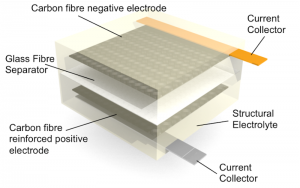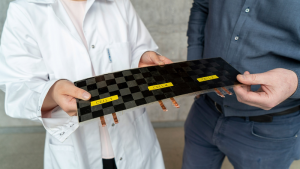Markus Zetterström has been appointed CEO of Sinonus, an offshoot of Chalmers Technical University and KTH, and part of Chalmers Ventures portfolio. At Sinonus, Markus Zetterström will be focusing on commercialising the groundbreaking technology of carbon fibre that doubles as battery electrodes, which the company is currently developing.
Sinonus has already demonstrated the potential of its technology by replacing AAA batteries in low-power products in its lab. The goal is to expand the technology to larger applications such as IoT devices, and eventually to drones, computers, larger vehicles, and even aeroplanes.
Carbon fibre is a strong and light construction material that can store energy electrochemically. Sinonus uses this multi-functionality to make true carbon-fibre-based structural batteries that not only store energy but also become an integral part of the product’s structure. This patented innovation represents a significant step forward in streamlining batteries and how they can be used.
The carbon fibre technology in Sinonus originates from Oxeon, another of Chalmers Venture’s portfolio companies. The carbon fibre was used in the propeller blades for NASA’s Ingenuity helicopter on Mars, chosen by the engineering team due to their ultralight weight and thinness.
“I’m thrilled to be joining Sinonus as CEO. The company’s innovative breakthrough in adding the dimension of electrical energy storage to carbon fibre has the potential to be truly transformative across a wide range of industries. I’m excited to work with the talented Sinonus team to unlock the full potential of this groundbreaking technology,” Markus Zetterström said.
For passenger aircraft to be powered by electricity, they need to be much lighter than they are today. A weight reduction is also very important for road vehicles, allowing them to extend the driving range per battery charge.
The batteries in today’s electric cars constitute a large part of the vehicles’ weight without fulfilling any load-bearing function. EVs can weigh almost 50 per cent more than regular cars due to their lithium-ion batteries, causing damage to roads, bridges, and parking garages.
A true structural battery can function as both a power source and as part of the structure, for example, in a car body.
“Storing electrical energy in carbon fibre may perhaps not become as efficient as traditional batteries, but since our carbon fibre solution also has a structural load-bearing capability, very large gains can be made at a system level,” Zetterström explained.
The development of structural batteries at Chalmers University of Technology has proceeded through many years of research, including previous discoveries involving certain types of carbon fibre. According to a study from the same university, the introduction of carbon fibre-based structural batteries could increase the driving range for lightweight EVs by 70 per cent. In addition, the lower energy density of structural batteries would make them safer than standard batteries, especially as they would also not contain any volatile substances.
”With his prior experience at Maurten and from leading strategy and transformation at SKF Group, Markus Zetterström is a valuable asset to Sinonus. His expertise will be instrumental in bringing their product from development to successful market launch. Chalmers Ventures are venture builders, meaning that in addition to funding, helping Sinonus find the perfect CEO matched our strategy perfectly,” said Pontus Ottosson, CEO at Chalmers Ventures.










